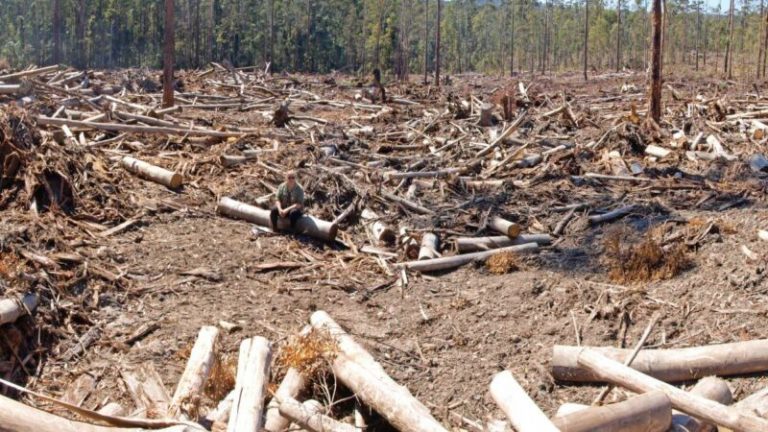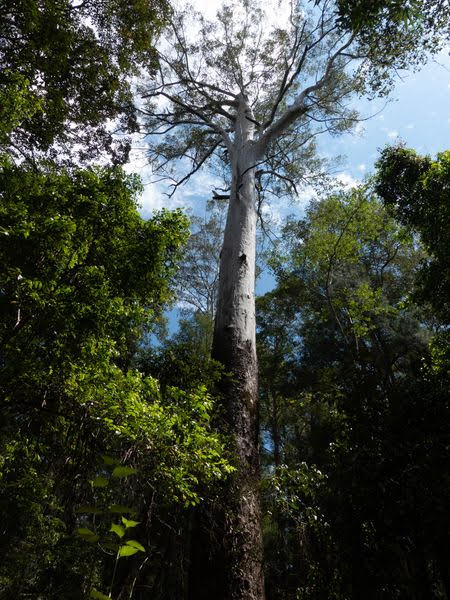

State-owned Forestry Corporation’s latest effort to start logging Oakes State Forest is threatening the NSW Government’s promised Great Koala National Park. It’s attracting local consternation and global condemnation, Sue Arnold reports.
Gigantic logging trucks and bulldozers tearing down trees, big old growth giants, fauna habitats, destroying endangered flora as the operation tramples everything in its path. All witnessed by devastated, angry people, desperate to end the annihilation.
A team of international scientists arriving at a site proposed for the Park have been shocked by the extensive large scale destructive logging, saying they did not expect a country like Australia would employ such logging practices.
Professor Helge Bruelheide, told ABC Radio that he believed the area should be declared World Heritage because of the unique combination of Gondwana rainforest variants as “these forests are unique globally, so unique that you won’t find in this particular combination elsewhere.”
The clear cutting employed by the Forestry Corporation is leaving few trees standing. Professor Bruelheide said that the proposed Koala park should be created without delay and logging should stop immediately. If not, he says,
there will be complete habitat destruction of trees, forest fauna and flora. Many of these species are already threatened with extinction.
Kalang forests
 Oakes State Forest is part of the Kalang forests which make up Kalang Headwaters, feeding the Kalang, Nambucca and Bellingen Rivers. The aquatic ecosystems supply residents of Urunga and Bellingen with their drinking water.
Oakes State Forest is part of the Kalang forests which make up Kalang Headwaters, feeding the Kalang, Nambucca and Bellingen Rivers. The aquatic ecosystems supply residents of Urunga and Bellingen with their drinking water.
Friends of Kalang Headwaters, a group that’s campaigned for years to have the area declared a Nature reserve, say emerging evidence demonstrates the aquatic ecosystems are amongst the oldest and most stable freshwater systems on the planet.
The catchment ensures water security for the viability of agricultural, fishing and tourism industries. Keeping all the forest cover is essential for the continuation of flowing rivers. Maintenance of cover is also important for rainfall, seeding new growth.
The Forestry Corporation is now able to log on steeper slopes to get to the big old trees so vital for threatened species with soil erosion spewing sediment into the river systems.
Logging destruction
Dr Timothy Cadman is monitoring the destruction currently caused by Forestry Corporation’s almost 20 km of roading and forestry operations to facilitate logging of Oakes.
In a letter to the Environmental Protection Agency, he wrote:
“The level of dust, up to six inches deep, is now making its way into the nearby nature reserve covering plants, making them inedible to a critical range of fauna. Already dust plumes are making their way down the drainages, ending up in the Kalang River and adjacent watercourses.“
No changes resulted from his letter.
Collectively, Kalang forests comprise a key component of a core Gondwanan refuge of critical significance for the survival of ancient ecosystems and species. Described as a “jewel in the crown” of the state’s native forests, Oakes many forest species are designated endangered under Commonwealth legislation.
Threats of extinction
One of the species threatened with extinction by the industrial logging of Oakes is the habitat of the Rufous scrub-bird, described by local citizen scientists as the “most ancient song bird on the planet”.

Rufous Scrub-bird
The Edge of Existence group, a leading UK conservation organisation, believe the Rufous Scrub-bird is a living fossil that evolved 97–65 million years ago. An elusive bird of high-elevation rainforest, the Rufous is confined to a tiny range in northern NSW and southern Queensland.
Kalang forests are steep and lush. They support a core population of nationally significant interconnected breeding populations of koalas. With ongoing destruction of habitat, shared by significant biodiversity, koalas are on the extinction juggernaut, too.
The Friends of Kalang headwaters website is getting more than 5000 hits a day from people outraged by the hypocrisy of the Labor government. Little wonder when Premier Chris Minns Facebook page declares that a koala patient at the Port Stephens wildlife hospital is excited by
our plan to help save Koalas from extinction in NSW.
What plan?
A response from the spokesperson for Minister for Agriculture, Regional NSW and Western NSW sums up the government’s policy of non-action.
- The Government has been clear from the start – we’re committed to a Great Koala National Park.
- When it comes to logging and the timber industry, I am working with my colleagues, my departments and stakeholders to get the balance right. We need a truly sustainable timber industry in NSW, as well as strong protection for crucial habitat.
In spite of the extraordinary extent and breadth of protests, Premier Minns and his Minister for the Environment, Penny Sharpe. remain deaf to the destruction.
The best Penny Sharpe can do is mouthing the same old “Saving koalas from extinction with the creation of the Great Koala National Park is Labor’s largest single environmental election commitment.”
Hollow words, Minister.
Main photo above: North Coast forests logged by Forestry Corp. (Image by Dailan Pugh, NEFA)
Michael West Media
https://www.michaelwest.com.au/

